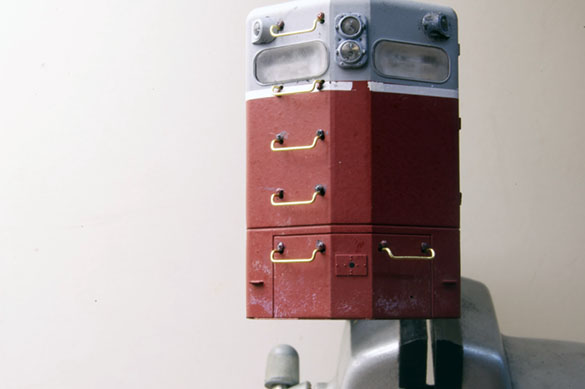I’d like to expand on the idea of using close-up photography as a check on my modeling.
Using photos as reality check helps me see things I routinely gloss over while working. The camera simply records what’s actually there, providing an objective view unclouded by any preconceived notions. That adage about how the camera doesn’t lie is true.
Work on the GP9 is taking a step or two backwards as I contend with the mistakes and sloppy workmanship revealed by my photos. Let’s have a look.
In this shot, things aren’t too bad but there are problems, namely the unsightly gaps where the grab irons enter the body caused by oversized holes. This is most visible with the grab just below the number board and the one on top.
The bolt head detail hid some of these gaps but they’re still visible in many places. Paint and weathering might have disguised them but the temptation there is to apply too much, which would only make matters worse.
Initially, I hoped I could preserve the paint job and just do some touch-up. This isn’t going to work and I’ve decided that a new paint scheme is in order after all the detailing is completed. The white stripe separating the red and gray is nothing more than a dry transfer decal. It was quite old and brittle and disintegrated as I applied it, so I removed it.
A new paint job gives me the freedom to properly deal with the gaps around the grab irons and I filled them with Bondo (an auto body filler) using flat toothpicks.
Once the filler dried I sanded the area using small emery boards with their ends cut to a sharp angle to reach into the tight spaces. Between the sanding and the subsequent rough handling, I lost a few of the bolt heads, but I have enough extras to replace them. Frustrating? Yes, but not insurmountable. In all, I’ve only lost a little working time but gained far more in the form of a better model.
Working from close-up photos forces you to deal with reality. With an increased awareness, you can choose to ignore sloppy work or fix it. My stated intention here and in the rest of my writing is to encourage you to always do your best and learn from mistakes in order to improve. If I let things slide, even little things that many consider inconsequential, then I lose credibility and far worse, I’m just lying to myself and to you about the kind of modeler I am.
Regards,
Mike
PS: After writing this text, I completed the body details and took a shot at repainting the shell. I’d like to report that the process went smoothly but… -Mike

If I let things slide, even little things that many consider inconsequential, then I lose credibility and far worse, I’m just lying to myself and to you about the kind of modeler I am.
What we think is immaterial. It’s how you feel about your modelling which counts.
Three stage guide to being “happy in one’s own skin”:
Set standards, stick to them, be happy.
Simon
I appreciate the sentiment Simon but, if I don’t live up to my own rhetoric, then I have no business putting it out for others to read.
To your point, I do feel good about the work I’m doing. Mistakes are frustrating, as is having to redo certain tasks, yet this is where the learning and improvement takes place.
Regards,
Mike
Ah, but you did let things slip! This is not a problem, as you realised this, owned up to it – to yourself – and set about doing it properly, and then told us all about it, because these things matter to you, as does your personal integrity.
Failing to live up to one’s own rhetoric is not always bad: it all depends on whether you are dismissing your stated ideals, or accepting that sometimes it takes more than one attempt.
To quote WCS, KBO!
Simon
If I may add to the above:
The greatest glory in living lies not in never falling, but in rising every time we fall.
– Nelson Mandela, “Long Walk to Freedom”
Simon